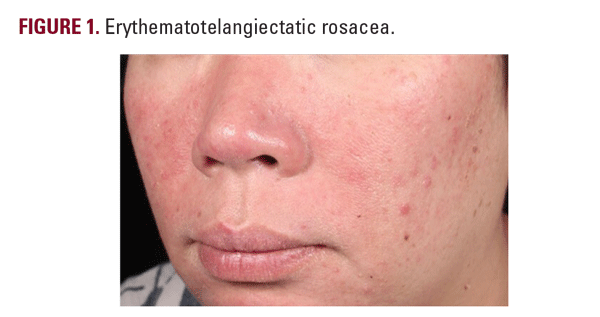


Most subjects were female with a ratio of 2.45 to 1, female to male, and the average age was 47.9 years old. Most patients had mild disease (n=417, 71.9%) and a single subtype (83.8%) of rosacea, with erythematotelangiectatic rosacea (ETR) being the most common (Figure 1). The mixed subtype was present in 16.2% of patients, where ETR combined with papulopustular rosacea (PPR) was the most common (69.1% of that group) (Figure 2). The emotional change was the most common trigger (299 patients, 51.7%), and stress was the second most common (280 patients, 48.4%), followed by hot weather, hot bathing, and spicy food.
Only 4.7% chose, “I know rosacea specifically.” The rest chose “I don't know rosacea at all” 47.4% (N = 275) or “I have heard about rosacea” 47.9% (N = 278). On average, patients had their “skin complaints” for 5 years. These numbers illustrate the need to increase the awareness of rosacea in Asian patients.
Another study focused on phymatous rosacea in Korean patients. This single-center, retrospective study in a Korean Department of Dermatology evaluated 39 patients whose primary rosacea manifestation was phymatous rosacea. They found a male to female ratio of 6.8:1; most patients (90%) were older than 40 years old, and mild grade rhinophyma was most common (46.1%), followed by moderate (41.0%) and severe (12.8%) rhinophyma (Figure 3). Most patients (70%) had lesions limited to the nose. The time from onset to development of severe rhinophyma took an average of 8.2 years.10
As the above studies illustrate, Asian patients with rosacea can have classic symptoms of rosacea, yet rosacea awareness is not always optimal. The need to increase awareness of rosacea in this population is further underscored by the association of rosacea with systemic comorbidities, which has also been illustrated in Asian populations.11-14
In a multi-institutional case-control study in 12,936 Korean patients with rosacea and 12,936 controls, researchers used logistic regression to identify significant associations between rosacea and multiple diseases.12 They found a significant association between rosacea and Sjögren syndrome, systemic sclerosis, rheumatoid arthritis, ankylosing spondylitis, autoimmune thyroiditis, alopecia areata, vitiligo, lung cancer, hepatobiliary cancer, alcohol abuse, type 2 diabetes mellitus, obesity, allergic disease, allergic conjunctivitis, chronic rhinosinusitis, herpes infection, and HPV infection.
Women with rosacea were more likely to have Sjögren syndrome, systemic sclerosis, ankylosing spondylitis, thyroiditis, vitiligo, hepatobiliary cancer, and obesity. Males were more likely to have alopecia areata and alcohol abuse. People at least 50 years old were more likely to have vitiligo, lung cancer, and gastroesophageal reflux disease. Ages less than 50 years old were associated with hepatobiliary cancer, allergic conjunctivitis, and irritable bowel syndrome.
Regarding mental health, using the National Health Insurance Research Database of Taiwan from 2000 to 2013, researchers evaluated 7881 patients with rosacea and 31,524 age- and sex-matched controls to study the role of rosacea in certain psychiatric disorders. They found an increased adjusted hazard ratio for phobic disorder 7.841 (95% CI = 7.526-8.170, P<0.001), for obsessive-compulsive disorder 6.389 (95% CI = 6.132-6.657, P<0.001), and for all considered disorders (anxiety, phobic disorder, obsessive-compulsive disorder, personality disorder, manic disorder, major depressive disorder, bipolar disorder, schizophrenia, attention deficit hyperactivity disorder) the total adjusted HR was 2.761, P<.001.13
Finally, to study the association between rosacea and cardiovascular diseases, associated comorbidities, and antihypertensive and antihyperlipidemic medications in Korea, researchers evaluated 2,536 patients with rosacea






